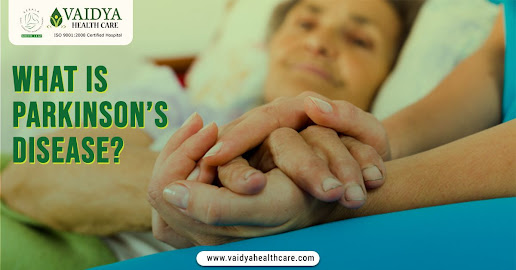Parkinson’s disease is a progressive neurological disorder that affects movement. Dopamine is a substance in the brain that facilitates smooth and coordinated muscle movements of the body. Dopamine is produced in a part of the brain called the substantia nigra. In Parkinson’s disease, the cells of substantia nigra began to die due to which the dopamine levels tend to decrease. When the dopamine levels dropped to 70-80%, symptoms of Parkinson’s began to appear.
In most cases, Parkinson's symptoms begin gradually and become worse over time. With the progression of the disease, people may face problems like difficulty in walking and talking, mental and behavioral changes, fatigue, depression, sleep problems, etc. Presently, there is no permanent cure for Parkinson’s disease; however, medications might help in improving your symptoms. Sometimes, surgery may be recommended by the doctor to regulate affected regions of your brain and alleviate your symptoms.
What are the risk factors?
Age: Generally, Parkinson’s develops between the ages of 50 and 60. Rarely it appears before the age of 40 in 5-10 percent of cases.
Family History: If you are a close relative to a Parkinson's patient, your chances to get Parkinson's disease are comparatively higher. However, your risks are still low unless many relatives of your family are associated with Parkinson's disease.
Sex: Both men and women can have Parkinson’s disease; however, men are one and a half times more likely to get Parkinson’s than women.
Head injury: People who have suffered from a head injury are more prone to Parkinson’s disease.
Toxins: Exposure to certain toxins is found to increase the risk of Parkinson’s disease.
What causes Parkinson’s disease?
In Parkinson's disease, certain nerve cells or neurons in the brain gradually began to die. Neurons produce a chemical messenger in your brain called dopamine and the loss of neurons leads to a decrease in the levels of dopamine. When dopamine levels reduce, it leads to abnormal brain activity that causes impaired movement, and symptoms of Parkinson's disease began to appear.
I) Genes: Various researches have revealed that certain specific genetic mutations can cause Parkinson's disease. However, this occurred very rarely only in cases where many family members are affected with Parkinson's disease.
II) Environmental factors: Researchers have found that environmental factors and exposure to certain toxins may increase the risk of Parkinson's disease. However, the risk is relatively low.
Studies also revealed that many changes occur in the brains of people with Parkinson's disease including:
Presence of Lewy bodies: Lewy bodies are the clumps of specific substances within brain cells. They are considered the microscopic markers of Parkinson's disease. Researchers believe that Lewy bodies possess an important signal to the cause of Parkinson's disease.
Alpha-synuclein found within Lewy bodies: One of the most important substances that is found in Lewy bodies is the natural and widespread protein known as alpha-synuclein (a-synuclein). It is seen to be found in a clumped form that cells can't break down. Researchers believe that this Alpha-synuclein can reveal a lot about Parkinson’s disease.
What are the symptoms of Parkinson’s disease?
a) Tremor: A tremor or shaking is one of the very common signs. Tremor or shaking may start in your hand or fingers. You may also get tremble when the hand is a rest.
b) Stiffness in muscles: Muscle stiffness may develop in the body or parts of the body. The stiffness of muscles can be painful and may restrict your movements.
c) Impaired postures and balance: One may lose his balance or their balance may become stooped as a result of Parkinson's disease.
d) Slowed movement (bradykinesia): As the disease progress, it may slow your movement and make simple tasks tough and time-consuming. Your steps may become smaller when you walk. You may have to drag your feet when you try to walk.
e) Changes in speech: One may find his speech soft or quick. He/she may slur or hesitate before talking.
f) Changes in writing: One can also find it very hard to write and their writing may appear small.
g) Reduction in automatic movements: One may experience a decline in the ability to perform unconscious movements including swinging your arms during walking, blinking, etc.
How Ayurveda has emerged as a ray of hope for people with Parkinson’s disease?
Ayurveda offers very effective treatment and therapies for the sufferers of Parkinson’s disease. An ayurvedic treatment plan is a composition of many procedures which eliminates the toxins from the body, revive your nervous system, and restore the digestive mechanism by using some unique herbal formulas.
Below are the ways in which Ayurveda can help Parkinson’s sufferer:
i) To cure digestive problems in patients, mild herbal laxatives are used for colon cleansing. Besides, Dietary advice is offered to improve the digestive, nervous and emotional systems in the body.
ii) Effective massage therapy using oils prepared by very effective herbs.
iii) The treasure of Ayurveda offers herbal nerve tonics to facilitate and nourish the nervous system.
iv) Use of herbal medications to improve symptoms of depression
v) Yoga and meditation practices are offered to reduce stress or anxiety, to rejuvenate internal energy, and to get rid of many physical and mental ailments.
Below are the Ayurvedic herbs that are used as a part of treatment:
i) Ashwagandha (Withania somnifera): Ashwagandha is found to be very effective in significantly improving motor neurons function.
ii) Kapikacchu (Mucuna pruriens): It is evident now that the extracts of the Mucuna pruriens seeds possess potent anti-Parkinsonian properties.
iii) Turmeric (Curcuma longa): - It is a neuro-protective agent as it is capable of crossing the blood-brain barrier and thus naturally helps in treating Parkinson.
iv) Garlic (Allium sativum): - Garlic extract is a wonderful mega resource that controls oxidative damage to neurons.
v) Brahmi (Bacopa monnieri): - Brahmi is a powerful remedy to naturally enhance memory and revitalizes brain function.













